WTO_AND_CHINA
- 格式:doc
- 大小:38.50 KB
- 文档页数:12
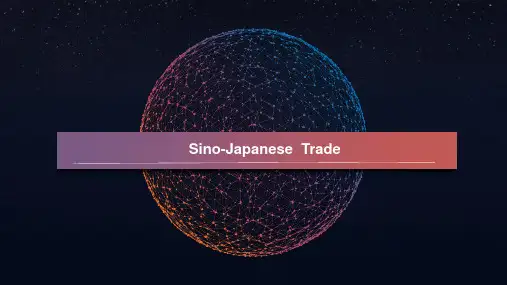
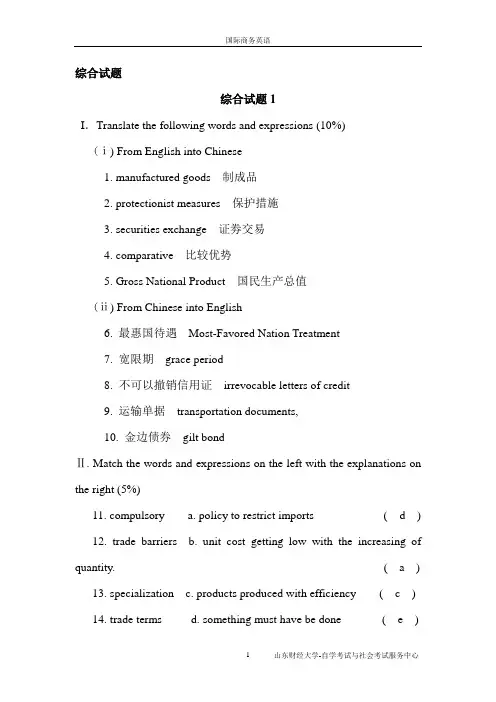
综合试题综合试题1I.Translate the following words and expressions (10%)(ⅰ) From English into Chinese1. manufactured goods 制成品2. protectionist measures 保护措施3. securities exchange 证劵交易4. comparative 比较优势5. Gross National Product 国民生产总值(ⅱ) From Chinese into English6. 最惠国待遇Most-Favored Nation Treatment7. 宽限期grace period8. 不可以撤销信用证irrevocable letters of credit9. 运输单据transportation documents,10. 金边债券gilt bondⅡ. Match the words and expressions on the left with the explanations on the right (5%)11. compulsory a. policy to restrict imports ( d )12. trade barriers b. unit cost getting low with the increasing of quantity. ( a )13. specialization c. products produced with efficiency ( c )14. trade terms d. something must have be done ( e )15. economics of scale: e. trade rules set by ICC ( b )Ⅲ. Make brief explanations of the following terms in English (20%) 16. quotaquota: the limited quantities or value of imports made by government for consideration to protect domestic industries.17. PPPPPP: purchasing power parity, a decisive factor for the change of exchange rate.18. deregulationderegulation: government lowers or abolishes some restrictive domestic or foreign economic policies and make the economic activity develop more freely.19. infrastructureinfrastructure: large-scale public services such as transportation, communication equipments.20. indemnityindemnity: a basic idea in all branches of insurance that the insured should be in the same position after a loss as he was before it, neither richer nor poorer as a result of loss.Ⅳ. Fill in each of the following blanks with an appropriate words (10% )Differs, Which, predecessor, mechanism. In one word, one, permanent, services, settle , World BankInstead of being a mere replacement of GATT, the WTO 21__differs__ from its22 __predecessor___ in several prominent dimension. Firstly, as the name suggests, he GATT is only an agreement, or more exactly an interim secretariat, 23__In one word__an organization entity in the true sense, while WTO is a full-fledged 24__permanent__organization. Secondly WTO has a much broader mandate promoting trade liberalization of goods and 25__services__.Thirdly, the WTO has established far greater enforcement powers to 26__settle__ trade frictions among member countries, 27__Which__is called dispute settlement 28__mechanism__.WTO has become 29__one__ of important three international economic organizations. The others two are 30.__World Bank__ and International Monetary Funds.Ⅴ. Translate the following into English (25%)31. 及时库存制源于日本,现在已经被很多国家企业采纳。
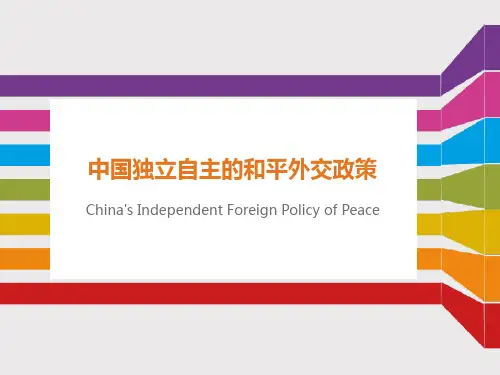
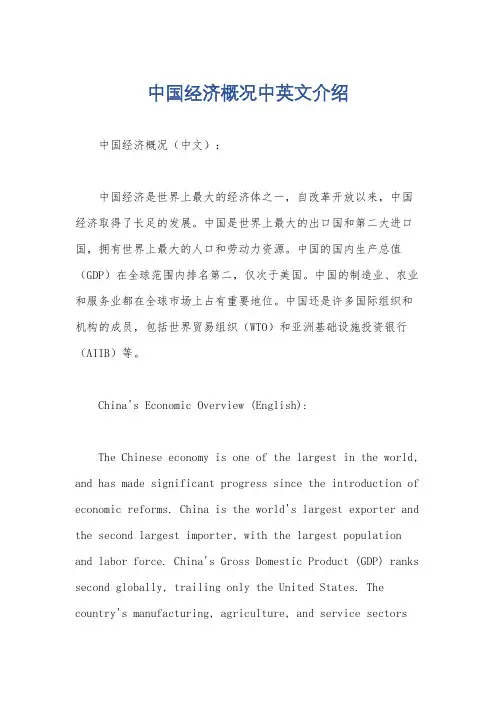
中国经济概况中英文介绍中国经济概况(中文):中国经济是世界上最大的经济体之一,自改革开放以来,中国经济取得了长足的发展。
中国是世界上最大的出口国和第二大进口国,拥有世界上最大的人口和劳动力资源。
中国的国内生产总值(GDP)在全球范围内排名第二,仅次于美国。
中国的制造业、农业和服务业都在全球市场上占有重要地位。
中国还是许多国际组织和机构的成员,包括世界贸易组织(WTO)和亚洲基础设施投资银行(AIIB)等。
China's Economic Overview (English):The Chinese economy is one of the largest in the world, and has made significant progress since the introduction of economic reforms. China is the world's largest exporter and the second largest importer, with the largest population and labor force. China's Gross Domestic Product (GDP) ranks second globally, trailing only the United States. The country's manufacturing, agriculture, and service sectorsall play significant roles in the global market. China is also a member of many international organizations and institutions, including the World Trade Organization (WTO) and the Asian Infrastructure Investment Bank (AIIB), among others.。
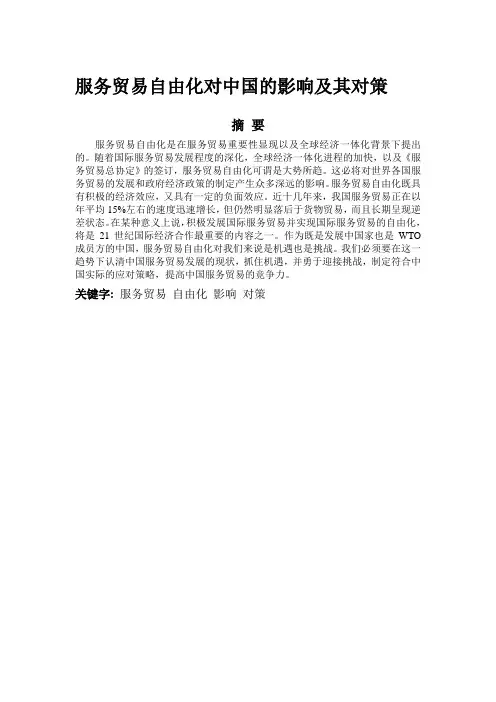
服务贸易自由化对中国的影响及其对策摘要服务贸易自由化是在服务贸易重要性显现以及全球经济一体化背景下提出的。
随着国际服务贸易发展程度的深化,全球经济一体化进程的加快,以及《服务贸易总协定》的签订,服务贸易自由化可谓是大势所趋。
这必将对世界各国服务贸易的发展和政府经济政策的制定产生众多深远的影响。
服务贸易自由化既具有积极的经济效应,又具有一定的负面效应。
近十几年来,我国服务贸易正在以年平均15%左右的速度迅速增长,但仍然明显落后于货物贸易,而且长期呈现逆差状态。
在某种意义上说,积极发展国际服务贸易并实现国际服务贸易的自由化,将是21世纪国际经济合作最重要的内容之一。
作为既是发展中国家也是WTO 成员方的中国,服务贸易自由化对我们来说是机遇也是挑战。
我们必须要在这一趋势下认清中国服务贸易发展的现状,抓住机遇,并勇于迎接挑战,制定符合中国实际的应对策略,提高中国服务贸易的竞争力。
关键字: 服务贸易自由化影响对策AbstractLiberalization of trade in services was put forward under the background of realization of the importance in service trade and globalization of world economy. With the promotion of international trade in services, the acceleration of the process of globalization of world economy and the signing of the "General Agreement on Trade in Services", liberalization of trade in services become a global trade. It will certainly have a strong impact on the development of each country's trade service and the economic policy of the government. Liberalization of trade in services has both positive effects and negative effects on economy. Because China is both a developing country and a WTO member, liberalization of trade in services is an opportunity as well as a challenge for us. Currently, we should get a clear understanding of the status quo in China's service trade development, try to seize the opportunity ,welcome the challenge and make the right strategies according to the facts of china. And finally we can improve our country's competitiveness of trade in services.Keywords: the liberalization of trade in services; influence; measures目录一、国际服务贸易以及服务贸易自由化的概述 (1)二、中国的国际服务贸易现状及其特点 (1)三、中国服务贸易存在的问题 (2)(一)第三产业发展滞后制约了服务贸易的发展 (2)(二)服务贸易发展不平衡,项目和地区结构过于集中 (2)(三)高附加值或技术含量较高的服务贸易落后 (3)(四)服务业国际竞争力较弱 (3)四、服务贸易自由化对中国的影响 (3)(一)服务贸易自由化对中国的积极影响 (3)1.有利于引入竞争机制 (3)2.有利于引进资金、技术和先进的管理方式 (3)3.有利于促进就业的增长 (4)4.有利于扩大服务贸易出口 (4)5.有利于推动我国服务企业国际化经营 (4)6.有利于带动我国国民经济的整体发展 (4)(二)服务贸易自由化对中国的消极影响 (4)1.对国内服务行业带来阻碍和挑战 (4)2.加剧服务贸易逆差 (5)3.加大我国国内服务业发展的不平衡 (5)五、发展我国服务贸易的对策 (5)(一)加快国内服务业发展,提高国内服务业的竞争力 (5)1.大力培育有竞争力的优势服务产业 (5)2.优化服务产业结构 (6)(二)大力发展教育事业,加快我国服务贸易专业人才的培养 (6)(三)建立与完善服务贸易的管理和协调机制 (6)(四)加快服务贸易的立法工作,制定和完善有关法律法规 (6)(五)实行循序渐进的开放模式 (7)(六)积极引进国外先进经验,先进技术来提高国内服务水平 (7)(七)积极参与服务贸易谈判,努力创造对我国有利的国际发展环境 (8)(八)积极参与区域经济合作,推动我国全面参与国际分工的进程 (8)一、国际服务贸易以及服务贸易自由化的概述国际服务贸易是指根据GA TT主持的乌拉圭回合谈判所签订的GA TS按照服务的提供方式,将国际服务贸易解释为自一成员领土向任何其他成员领土提供服务;在一成员领土内向任何其他成员的服务消息者提供的服务;一成员的服务提供者通过在任何其他成员领土内的商业存在提供服务;一成员的服务提供者通过在任何其他成员领土内的自然人存在提供的服务。
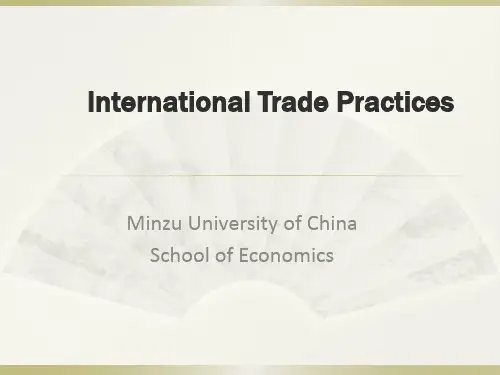
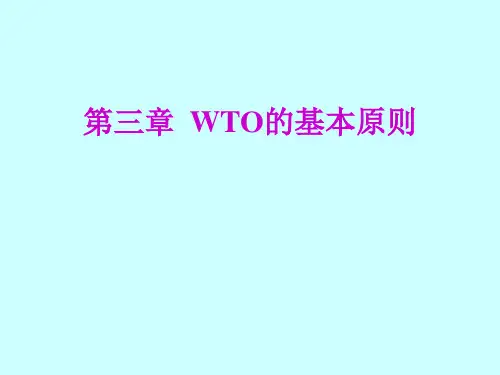
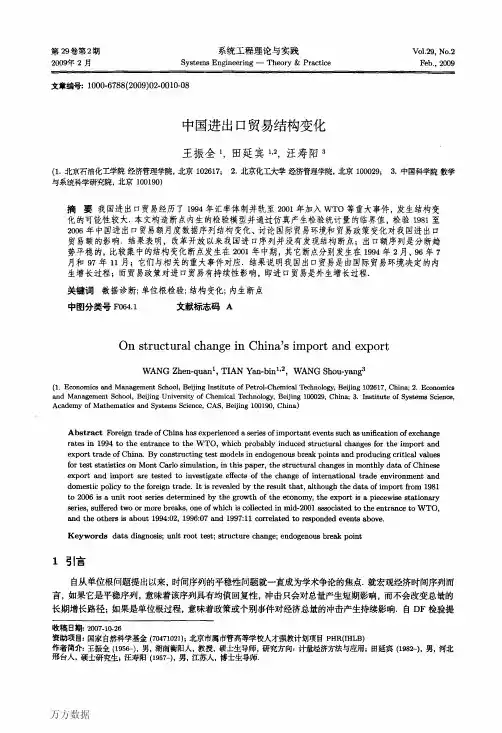
第29卷第2期2009年2月系统工程理论与实践SystemsEngineering—Theory&PracticeV01.29,No.2Feb.,2009文章编号:1000-6788(2009)02—0010—08中国进出口贸易结构变化王振全・,田延宾L2,汪寿阳s(1.北京石油化工学院经济管理学院,北京102617;2。
北京化工大学经济管理学院,北京100029;3.中国科学院数学与系统科学研究院,北京100190)摘要我国进出口贸易经历了1994年汇率体制并轨至2001年加入WTO等重大事件,发生结构变化的可能性较大.本文构造断点内生的检验模型并通过仿真产生检验统计量的临界值,检验1981至2006年中国进出口贸易额月度数据序列结构变化、讨论国际贸易环境和贸易政策变化对我国进出口贸易额的影响.结果表明,改革开放以来我国进i=/序列并没有发现结构断点;出口额序列是分断趋势平稳的,比较集中的结构变化断点发生在2001年中期,其它断点分别发生在1994年2月、96年7月和97年11月;它们与相关的重大事件对应.结果说明我国出口贸易是由国际贸易环境决定的内生增长过程;而贸易政策对进口贸易有持续性影响,即进口贸易是外生增长过程.关键词数据诊断;单位根检验;结构变化;内生断点中图分类号F064.1文献标志码AOnstructuralchangeinChina’SimportandexportWANGZhen-quanl,TIANYan-binl,一,WANGShou-yan93(1.EconomicsandManagementSchool,BeijingInstituteofPetrol-ChemicalTechnology,Beijing102617,China;2.EconomicsandManagementSchool,BeijingUniversityofChemicalTechnology,Beijing100029,China;3.InstituteofSystemsScience,AcademyofMathematicsandSystemsScience,CAS,Beijing100190,China)AbstractForeigntradeofChinahasexperiencedaseriesofimportanteventssuchaSunificationofexchangeratesin1994totheentrancetotheWTO.whichprobablyinducedstructuralchangesfortheireportandexporttradeofChina.Byconstructingtestmodel8inendogenousbreakpointsandproducingcriticalvaluesforteststatisticsonMontCarlosimulation。
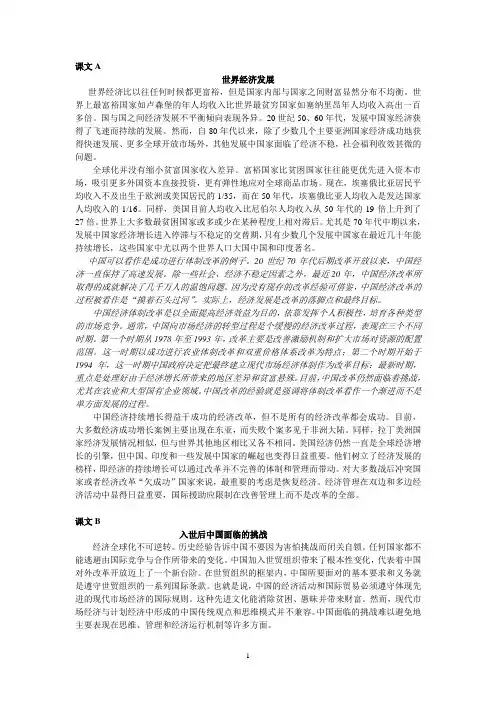
课文A世界经济发展世界经济比以往任何时候都更富裕,但是国家内部与国家之间财富显然分布不均衡。
世界上最富裕国家如卢森堡的年人均收入比世界最贫穷国家如塞纳里昂年人均收入高出一百多倍。
国与国之间经济发展不平衡倾向表现各异。
20世纪50、60年代,发展中国家经济获得了飞速而持续的发展。
然而,自80年代以来,除了少数几个主要亚洲国家经济成功地获得快速发展、更多全球开放市场外,其他发展中国家面临了经济不稳,社会福利收效甚微的问题。
全球化并没有缩小贫富国家收入差异。
富裕国家比贫困国家往往能更优先进入资本市场,吸引更多外国资本直接投资,更有弹性地应对全球商品市场。
现在,埃塞俄比亚居民平均收入不及出生于欧洲或美国居民的1/35,而在50年代,埃塞俄比亚人均收入是发达国家人均收入的1/16。
同样,美国目前人均收入比尼伯尔人均收入从50年代的19倍上升到了27倍。
世界上大多数最贫困国家或多或少在某种程度上相对滞后。
尤其是70年代中期以来,发展中国家经济增长进入停滞与不稳定的交替期,只有少数几个发展中国家在最近几十年能持续增长,这些国家中尤以两个世界人口大国中国和印度著名。
中国可以看作是成功进行体制改革的例子。
20世纪70年代后期改革开放以来,中国经济一直保持了高速发展。
除一些社会、经济不稳定因素之外,最近20年,中国经济改革所取得的成就解决了几千万人的温饱问题。
因为没有现存的改革经验可借鉴,中国经济改革的过程被看作是“摸着石头过河”。
实际上,经济发展是改革的落脚点和最终目标。
中国经济体制改革是以全面提高经济效益为目的,依靠发挥个人积极性,培育各种类型的市场竞争。
通常,中国向市场经济的转型过程是个缓慢的经济改革过程,表现在三个不同时期。
第一个时期从1978年至1993年,改革主要是改善激励机制和扩大市场对资源的配置范围。
这一时期以成功进行农业体制改革和双重价格体系改革为特点;第二个时期开始于1994年,这一时期中国政府决定把最终建立现代市场经济体制作为改革目标;最新时期,重点是处理好由于经济增长所带来的地区差异和贫富悬殊。
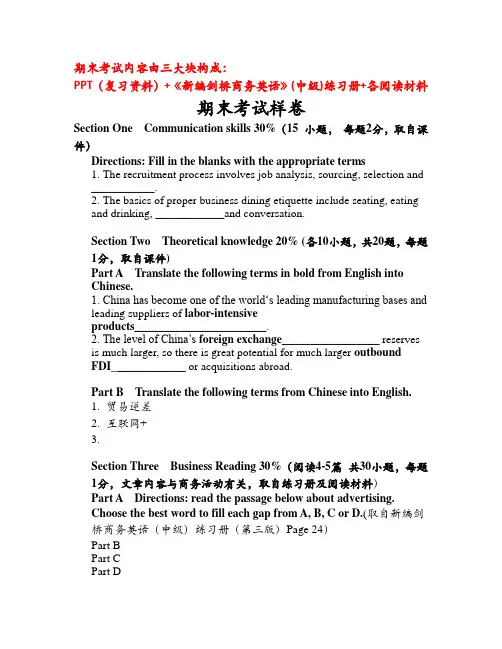
期末考试内容由三大块构成:PPT(复习资料)+《新编剑桥商务英语》(中级)练习册+各阅读材料期末考试样卷Section One Communication skills 30%(15 小题,每题2分,取自课件)Directions: Fill in the blanks with the appropriate terms1. The recruitment process involves job analysis, sourcing, selection and___________.2. The basics of proper business dining etiquette include seating, eatingand drinking, ____________and conversation.Section Two Theoretical knowledge 20% (各10小题,共20题,每题1分,取自课件)Part A Translate the following terms in bold from English intoChinese.1. China has become one of the world‗s leading manufacturing bases andleading suppliers of labor-intensiveproducts_______________________.2. The level of China‘s foreign exchange_________________ reservesis much larger, so there is great potential for much larger outboundFDI_____________ or acquisitions abroad.Part B Translate the following terms from Chinese into English.1. 贸易逆差2. 互联网+3.Section Three Business Reading 30%(阅读4-5篇共30小题,每题1分,文章内容与商务活动有关,取自练习册及阅读材料)Part A Directions: read the passage below about advertising.Choose the best word to fill each gap from A, B, C or D.(取自新编剑桥商务英语(中级)练习册(第三版)Page 24)Part BPart CPart DSection Four Business Writing 20%Directions:Read the information and use the framework below to write a report(取自新编剑桥商务英语(中级)练习册(第三版)Page 23).PPT(复习资料)Unit 1 Top Companies and Globalization Business Theory1. What is a Company?A company is an association or collection of individuals,whether natural persons,legal persons, or a mixture of both, who sharea common purpose and unite in order to focus their various talentsand organize their collectively available skills or resources to achieve specific, declared goals.All companies excluding non-profit organizations are benefit driving.A Company Should be Unique!A company is different from others because it has its unique corporateculture.The person who organizes and manages an enterprise, especially a business, usually with considerable initiative and risk, is called an entrepreneur. It is entrepreneurship that involves in the process of designing, launching and running a new business.Similar Wordsfirm business corporation multinational conglomeratedot-com subsidiary affiliateLtd./Co. VS company of unlimited liabilityRelative Wordsheadquarters branch departmentCEO: chief executive manager managing director 总经理/常务董事chairman of the board board of directorsPhrase Collocationrun/set up a companyjoin a company: become an employeea company goes bust/bankruptcompany policyCommon Types of Businesslimited-liability company(责任有限公司)unlimited company(责任无限公司)listed company(上市公司)domestic enterprise(内资企业)foreign-owned/invested enterprise(外企)overseas-funded enterprise(海外投资企业)state-owned enterprise(国企)private enterprise/business(私企)(Sino-foreign)joint venture(中外合资)2. What Does Globalization Mean?The term ―globalization‖ was first used in a scholarly fashion in 1967.Globalization is the process of international integration arising from the interchange of world views, products, ideas and mutual sharing, and other aspects of culture. It comes together with economic integration(经济一体化).3. Four Aspects of Globalizationtrade and transactionscapital and investment movementsmigration and movement of peoplethe dissemination of knowledge4. What are Important Marks in the History of Globalization?The Silk Road/the rise of maritime European empires/multinational enterprises and international trade/bilateral, multinational and international cooperation and organization: WTO, EU, TPP/the Internet has brought communities across the globe closer together through instant communication..5. What is SWOT Analysis?SWOT analysis, also called SWOT matrix, is a structured planning method used to evaluate the strengths, weaknesses, opportunities and threats involved in a project or in a business. Fortune 500 and Transnational CorporationsThe most famous companies in the world are included in Fortune Global 500 list, also known as Global 500, which is an annual ranking of the top 500corporations worldwide as measured by revenue. The list is compiled and published annually by Fortune magazine, an American business magazine, published globally by Time Inc. In 2015, the top 10 companies: Walmart(沃尔玛), Sinopec(中石化)Dutch Shell(荷兰皇家壳牌石油公司)China National Petroleum Corporation(中国石油天然气集团公司) ExxonMobil(埃克森美孚), BP(英国石油公司)State Grid Corporation of China(中国国家电网公司)Volkswagen(大众集团公司), Toyota Motor(丰田汽车)Glencore(嘉能可-全球大宗商品交易巨头)6. What are Transnational Corporations/Multinational Companies?A m ultinational corporation or multinational company, is anorganization that owns or controls production of goods or services in one or more countries other than their home country. It can also be referred as an international corporation, a "transnational corporation", or a stateless corporation.7. How to Make a Presentation?Step A: Introducing the presentationUseful expressions: Good morning and thanks for coming/Today I‘dlike to tell you about…Step B: Explaining the structure of the presentationUseful expressions: If you have any questions, I‘ll be happy to answer them at the end/Then I‘ll give you an overview of/In my brief presentation we‘ll begin by looking at…Step C: Presenting the first partUseful expressions: Here you can see/First of all there‘s…/and finally there‘s...Step D: Presenting the second partUseful expressions: OK, let‘s move on to look at/One thing I‘d like to point out is/Take a look at this chart…Step E: Presenting the third partStep F: Ending the presentationUseful expressions: Are there any questions/ So that brings me to the end of the presentation/Thanks for listening…Unit 2 Starting a BusinessBusiness Theory1. WTO(originated from GATT-General Agreement on Tariffs and Trade) isa place where member governments go, to try to sort out the trade problems they face with each other. At its heart are the WTO agreements, negotiated and signed by the bulk of the world‘s tra ding nations.But the WTO is not just about liberalizing trade, and in some circumstances its rules support maintaining trade barriers —for example to protect consumers, prevent the spread of disease or protect the environment.2. WTO Benefits1. This system helps promote peace.2. Disputes are handled constructively.3. Rules make life easier for all.4. Free trade cuts the cost of living.5. It provides more choices of products and qualities.6. Trade raises incomes.7. Trade stimulates economic growth.8. The basic principles make life more efficient.9. Governments are shielded from lobbying.10. The system encourages good government.3. What is Anti-dumping Agreement?If a company exports a product at a price lower than the price it normally charges on its own home market, it is said to be ―dumping‖ the product. The WTO Agreement does not regulate the actions of companies engaged in"dumping". Its focus is on how governments can or cannot react to dumping —it disciplines anti-dumping actions, and it is often called the ―Anti-dumping Agreement‖.Types of BusinessSole trader you are self-employed and set up the business on your own. Partnership you are self-employed and start the business with another person. You are both equally liable.Franchise you buy a license to trade under the name of the franchiser and you benefit from the franchiser‘s expertise.Internet start-up you start a business online like Taobao C2C shop with small investment.Internal venture you may undertake part of a business in a company. It‘s highly motivated at Haier.Unit 3 AdvertisingBusiness Theory1. When did people begin to trade? Clear evidence of trading overlong distances dates back at least 9,000 years.2. How did ancient people trade? People trade because they don‘t haveeverything they need.Trade can make everyone better off.3. Why do countries trade? Countries trade with each other when, ontheir own, they do not have the resources, or capacity to satisfy their own needs and wants. Trade comes from division of labor andspecialization. Division of labor makes trade possible and specialization can generate further benefits in terms of efficiency and productivity.4.What is comparative advantage?The theory of comparative advantage is an economic theory about thework gains from trade for individuals, firms, or nations that arise from differences in their factor endowments (要素禀赋)or technologicalprogress. If an agent(经济学中一般人的抽象) can produce a good at a lower relative opportunity cost, he has comparative advantage inproducing this good. Factors are what can be used in production likeland, capital and labor, etc. Endowments are the quality and quantity of something.David Ricardo(in 1817) realized that absolute advantage(by Adam Smith)was a limited case. Countries without absolute advantage can get gains by trading products they have comparative advantage in producing.5. What products and services does a country tend to trade withothers? Each country tends to trade with others products and services in which they have comparative advantages. Comparative advantages come from factor endowments and technological development.technology-intensive/labor-intensiveAdvertisingAdvertising is an important part of marketing. It aims to make people aware of a product or service and favorably incline towards it. A manufacturer can amplify the demand of a product by advertising widely.It can build the consumer‘s brand preference and loyalty, thus increasing the value of the product. Advertising is helpful to build the brand, increase the value of its goodwill and win the confidence of consumer.Useful expressions1. The advertisement is used to promote…这广告是促销…2. The target customers of the advertisement are …这广告的目标客是….3.it is obvious that …很显然… creative ideas 有创意的想法4.I (don‘t) think it is effective because….我认为这广告效果很好(没有达到很好的效果)5. paper diaper (纸尿裤)parent-child clothes亲子装6.roller skating 滑旱冰roller baby 旱冰宝宝7. performing their stunts 表演特技facial expressions面部表情8. have a strong visual impact有很强的视觉冲击力/效果9. leave a deep impression on sb/ impress sb deeply 给某人留下很深的印象10. Xx company targets a more upscale marketxx公司目标客户定位在上层市场(高端市场)11. marketing strategies 市场营销策略12.send the link to my friends easily很容易把链接发给朋友13. creating links to increase traffic 创造连接提高点击率14. driven by the commercial interests ,由于商业利益的驱使,15. in order to achieve the good effectiveness of remembering为了良好的广告记住效应,16. using the method of repeating advertising slogans17. wool fabric/woolen knitwear 毛纺织品knitting wool毛线18 . Have a strong visual and auditory impact 有很强的视听效果19. audience ratings (电视、广播的)视听率,收视率20. the effectiveness of …has been impaired/weakened消弱了…的效果21. vulgar television advertisement;恶俗电视广告22. appear frequently频频出现;23. It is the most interesting ads that I‘ve ever seen.这是我看过的最有趣的广告。
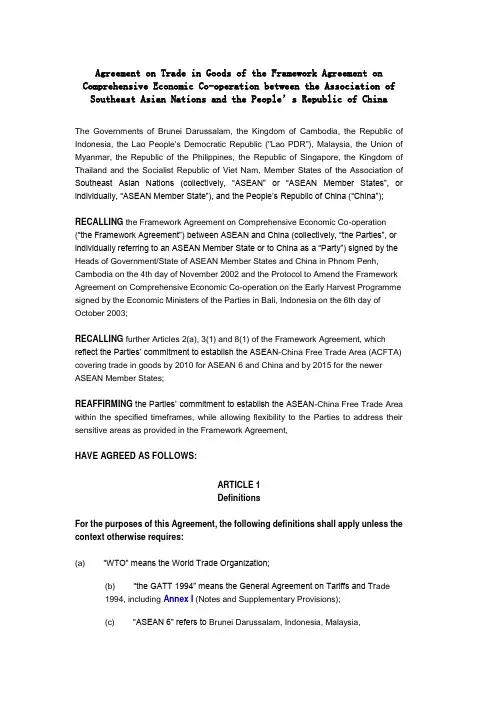
Agreement on Trade in Goods of the Framework Agreement on Comprehensive Economic Co-operation between the Association of Southeast Asian Nations and the People’s Republic of ChinaThe Governments of Brunei Darussalam, the Kingdom of Cambodia, the Republic of Indonesia, the Lao People's Democratic Republic ("Lao PDR"), Malaysia, the Union of Myanmar, the Republic of the Philippines, the Republic of Singapore, the Kingdom of Thailand and the Socialist Republic of Viet Nam, Member States of the Association of Southeast Asian Nations (collectively, “ASEAN” or “ASEAN Member States”, or individually, “ASEAN Member State”), and the People’s Republic of China (“China”);RECALLING the Framework Agreement on Comprehensive Economic Co-operation (“the Framework Agreement”) between ASEAN and China (collectively, “the Parties”, or individually referring to an ASEAN Member State or to China as a “Party”) signed by the Heads of Government/State of ASEAN Member States and China in Phnom Penh, Cambodia on the 4th day of November 2002 and the Protocol to Amend the Framework Agreement on Comprehensive Economic Co-operation on the Early Harvest Programme signed by the Economic Ministers of the Parties in Bali, Indonesia on the 6th day of October 2003;RECALLING further Articles 2(a), 3(1) and 8(1) of the Framework Agreement, which reflect the Parties’ commitment to establish the ASEAN-China Free Trade Area (ACFTA) covering trade in goods by 2010 for ASEAN 6 and China and by 2015 for the newer ASEAN Member States;REAFFIRMING the Parties’ commitment to establish the ASEAN-China Free Trade Area within the specified timeframes, while allowing flexibility to the Parties to address their sensitive areas as provided in the Framework Agreement,HAVE AGREED AS FOLLOWS:ARTICLE 1DefinitionsFor the purpose s of this Agreement, the following definitions shall apply unless the context otherwise requires:(a) “WTO” means the World Trade Organization;(b) “the GATT 1994” means the General Agreement on Tariffs and Tr ade1994, including Annex I (Notes and Supplementary Provisions);(c) “ASEAN 6” refers to Brunei Darussalam, Indonesia, Malaysia,thePhilippines, Singapore and Thailand;(d) “newer ASEAN Member States” refers to Cambodia, LaoPDR,Myanmar and Viet Nam;(e) “applied MFN tariff rates” shall include in-quota rates, and shall:(i) in the case of ASEAN Member States (which are WTO membersas of 1 July 2003) and China, refer to their respective applied rates asof 1 July 2003; and(ii) in the case of ASEAN Member States (which are non-W TOmembers as of 1 July 2003), refer to the rates as applied to China as of1July 2003;(f) “non-tariff measures” shall include non-tariff barriers;(g) “AEM” means ASEAN Economic Ministers;(h) “MOFCOM” means Ministry of Commerce of China;(i) “SEOM” means ASEAN Senior Economic Officials Meeting.ARTICLE 2National Treatment on Internal Taxation and RegulationEach Party shall accord national treatment to the products of all the other Parties covered by this Agreement and the Framework Agreement in accordance with Article III of the GATT 1994. To this end, the provisions of Article III of the GATT 1994 shall,mutatis mutandis, be incorporated into and form an integral part of this Agreement.ARTICLE 3Tariff Reduction and Elimination1. The tariff reduction or elimination programme of the Parties shall require the applied MFN tariff rates on listed tariff lines to be gradually reduced and where applicable, eliminated, in accordance with this Article.2. The tariff lines which are subject to the tariff reduction or elimination programme ubder this Agreement shall include all tariff lines not covered by the Early Harvest Programme under Article 6 of the Framework Agreement, and such tariff lines shall be categorised for tariff reduction and elimination as follows:(a)Normal Track: Tariff lines placed in the Normal Track by eachParty on its own accord shall have their respective applied MFN tariffrates gradually reduced and eliminated in accordance with the modalitiesset out in Annex 1 of this Agreement with the objective of achieving thetargets prescribed in the thresholds therein.(b) Sensitive Track: Tariff lines placed in the Sensitive Track by eachParty on its own accord shall have their respective applied MFN tariffrates reduced or eliminated in accordance with the modalities set outin Annex 2of this Agreement.3. Subject to Annex 1 and Annex 2 of this Agreement, all commitments undertaken by each Party under this Article shall be applied to all the other Parties.ARTICLE 4TransparencyArticle X of the GATT 1994 shall, mutatis mutandis, be incorporated into and form an integral part of this Agreement.ARTICLE 5Rules of OriginThe Rules of Origin and the Operational Certification Procedures applicable to the products covered under this Agreement and the Early Harvest Programme of the Framework Agreement are set out in Annex 3 of this Agreement.ARTICLE 6Modification of Conce ssions1. Any Party to this Agreement may, by negotiation and agreement with any Party to which it has made a concession under this Agreement, modify or withdraw such concession made under this Agreement.2. In such negotiations and agreement, which may include provision for compensatory adjustment with respect to other products, the Parties concerned shall maintain a general level of reciprocal and mutually advantageous concessions not less favourable to trade than that provided for in this Agreement prior to such negotiations and agreement.ARTICLE 7WTO Disciplines1. Subject to the provisions of this Agreement and any future agreements as may be agreed pursuant to reviews of this Agreement by the Parties under Article 17 of thisAgreement, the Parties[1] hereby agree and reaffirm their commitments to abide by the provisions of the WTO disciplines on, among others, non-tariff measures, technical barriers to trade, sanitary and phytosanitary measures, subsidies and countervailing measures, anti-dumping measures and intellectual property rights.2. The provisions of the W TO Multilateral Agreements on Trade in Goods, which are not specifically mentioned in or modified by this Agreement, shall apply,mutatis mutandis, to this Agreement unless the context otherwise requires.ARTICLE 8Quantitative Restrictions and Non-Tariff Barriers1. Each Party undertakes not to maintain any quantitative restrictions at any time unless otherwise permitted under the WTO disciplines.[2]2. The Parties shall identify non-tariff barriers (other than quantitative restrictions) for elimination as soon as possible after the entry into force of this Agreement. The time frame for elimination of these non-tariff barriers shall be mutually agreed upon by all Parties.3. The Parties shall make information on their respective quantitative restrictions available and accessible upon implementation of this Agreement.ARTICLE 9Safeguard Measures1.Each Party, which is a WTO member, retains its rights and obligations under Article X IX of the GATT 1994 and the W TO Agreement on Safeguards.2.With regard to ACFTA safeguard measures, a Party shall have the right to initiate such a measure on a product within the transition period for that product. The transition period for a product shall begin from the date of entry into force of this Agreement and end five years from the date of completion of tariff elimination/reduction for that product.3. A Party shall be free to take ACFTA safeguard measures if as an effect of the obligations incurred by that Party, including tariff concessions under the Early Harvest Programme of the Framework Agreement or this Agreement, or, if as a res ult of unforeseen developments and of the effects of the obligations incurred by that Party, including tariff concessions under the Early Harvest Programme of the Framework Agreement or this Agreement, imports of any particular product from the other Parties increase in such quantities, absolute or relative to domestic production, and under such conditions so as to cause or threaten to cause serious injury to the domestic industry ofthe importing Party that produces like or directly competitive products.4. If an ACFTA safeguard measure is taken, a Party taking such a measure may increase the tariff rate applicable to the product concerned to the W TO MFN tariff rate applied to such product at the time when the measure is taken.5. Any ACFTA safeguard measure may be maintained for an initial period of up to 3 years and may be extended for a period not exceeding 1 year. Notwithstanding the duration of an ACFTA safeguard measure on a product, such measure shall terminate at the end of the transition period for that product.6. In applying ACFTA safeguard measures, the Parties shall adopt the rules for the application of safeguard measures as provided under the WTO Agreement on Safeguards, with the exception of the quantitative restriction measures set out in Article 5, and Articles 9, 13 and 14 of the W TO Agreement on Safeguards. As such, all other provisions of the W TO Agreement on Safeguards shall, mutatis mutandis, be incorporated into and form an integral part of this Agreement.7. An ACFTA safeguard measure shall not be applied against a product originating in a Party, so long as its share of imports of the product concerned in the importing Party does not exceed 3% of the total imports from the Parties.8. In seeking compensation under Article 8 of the WTO Agreement on Safeguards for an ACFTA safeguard measure, the Parties shall seek the good offices of the body referred to in paragraph 12 to determine the substantially equivalent level of concessions prior to any suspension of equivalent concessions. Any proceedings arising from such good offices shall be completed within 90 days from the date on which the ACFTA safeguard measure was applied.9. On a Party’s termination of an ACFTA safeguard measure on a product, the tariff rate for that product shall be the rate that, according to that Party’s tariff reduction and elimination schedule, as provided in Annex 1 and Annex 2 of this Agreement, would have been in effect commencing on 1 January of the year in which the safeguard measure is terminated.10. All official communications and documentations exchanged among the Parties and to the body referred to in paragraph 12 relating to any ACFTA safeguard measures shall be in writing and shall be in the English language.11. When applying ACFTA safeguard measures, a Party shall not have simultaneous recourse to the WTO safeguard measures referred to in paragraph 1.12. For the purpose of this Article, any reference to “Council for Trade in Goods” or the “Committee on Safeguards” in the incorporated provisions of the WTO Agreement onSafeguards shall, pending the establishment of a permanent body under paragraph 1 of Article 16, refer to the AEM-MOFCOM, or the SEOM-MOFCOM, as appropriate, which shall be replaced by the permanent body once it is established.ARTICLE 10Acceleration of CommitmentsNothing in this Agreement shall preclude the Parties from negotiating and entering into arrangements to accelerate the implementation of commitments made under this Agreement, provided that such arrangements are mutually agreed to and implemented by all the Parties.ARTICLE 11Measure s to Safeguard the Balance of PaymentsWhere a Party is in serious balance of payments and external financial difficulties or threat thereof, it may, in accordance with the GATT 1994 and the Understanding on Balance-of-Payments Provisions of the GATT 1994, adopt restrictive import measures.ARTICLE 12General ExceptionsSubject to the requirement that such measures are not applied in a manner which would constitute a means of arbitrary or unjustifiable discrimination between the Parties where the same conditions prevail, or a disguised restriction on international trade, nothing in this Agreement shall be construed to prevent the adoption or enforcement by a Party of measures:(a) necessary to protect public morals;(b) necessary to protect human, animal or plant life or health;(c) relating to the importations or exportations of gold or silver;(d) necessary to secure compliance with laws or regulations which are notinconsistent with the provisions of this Agreement, including those relating to customs enforcement, the enforcement of monopolies operated under paragraph4 of Article II and Article X VII of the GATT 1994, the protection of patents, trademarks and copyrights, and the prevention of deceptive practices;(e) relating to the products of prison labour;(f) imposed for the protection of national treasures of artistic, historic orarchaeological value;(g) relating to the conservation of exhaustible natural resources if such measures aremade effective in conjunction with restrictions on domestic production or consumption;(h) undertaken in pursuance of obligations under any intergovernmental commodityagreement which conforms to criteria submitted to the WTO and not disapproved by it or which is itself so submitted and not so disapproved;(i) involving restrictions on exports of domestic materials necessary to ensureessential quantities of such materials to a domestic processing industry during periods when the domestic price of such materials is held below the world price as part of a governmental stabilization plan; Provided that such restrictions shall not operate to increase the exports of or the protection afforded to such domestic industry, and shall not depart from the provisions of this Agreement relating to non-discrimination;(j) essential to the acquisition or distribution of products in general or local short supply; Provided that any such measures shall be consistent with the principle that all Parties are entitled to an equitable share of the international supply of such products, and that any such measures, which are inconsistent with the other provisions of this Agreement shall be discontinued as soon as the conditions giving rise to them have ceased to exist.ARTICLE 13Security ExceptionsNothing in this Agreement shall be construed:(a) to require any Party to furnish any information the disclosure of which it considerscontrary to its essential security interests;(b) to prevent any Party from taking any action which it considers necessary for theprotection of its essential security interests, including but not limited to:(i) action relating to fissionable materials or the materials from whichthey are derived;(ii) action relating to the traffic in arms, ammunition and implementsof war and to such traffic in other goods and materials as is carried ondirectly or indirectly for the purpose of supplying a military establishment;(iii) action taken so as to protect critical communications infrastructure from deliberate attempts intended to disable or degrade such infrastructure;(iv) action taken in time of war or other emergency in domestic orinternational relations; or(c) to prevent any Party from taking any action in pursuance of its obligations underthe United Nations Charter for the maintenance of international peace and security.ARTICLE 14Recognition of China’s Market Economy StatusEach of the ten ASEAN Member States agrees to recognise China as a full market economy and shall not apply, from the date of the signature of this Agreement, Sections 15 and 16 of the Protocol of Accession of the People’s Republic of China to the WTO and Paragraph 242 of the Report of the Working Party on the Accession of China to WTO in relation to the trade between China and each of the ten ASEAN Member States.ARTICLE 15State, Regional and Local GovernmentIn fulfilling its obligations and commitments under this Agreement, each Party shall ensure their observance by regional and local governments and authorities in its territory as well as their observance by non-governmental bodies (in the exercise of powers delegated by central, state, regional or local governments or a uthorities) within its territory.ARTICLE 16Institutional Arrangements1. Pending the establishment of a permanent body, the AEM-MOFCOM, supported and assisted by the SEOM-MOFCOM, shall oversee, supervise, coordinate and review the implementation of this Agreement.2. The ASEAN Secretariat shall monitor and report to the SEOM-MOFCOM on the implementation of this Agreement. All Parties shall cooperate with the ASEAN Secretariat in the performance of its duties.3. Each Party shall designate a contact point to facilitate communications between the Parties on any matter covered by this Agreement. On the request of a Party, the contact point of the requested Party shall identify the office or official responsible for the matter and assist in facilitating communication with the requesting Party.ARTICLE 17Review1.The AEM-MOFCOM or their designated representatives shall meet within a year of the date of entry into force of this Agreement and then biennially or otherwise as appropriate to review this Agreement for the purpose of considering further measures to liberalise trade in goods as well as develop disciplines and negotiate agreements on matters referred to in Article 7 of this Agreement or any other relevant matters as may be agreed.2.The Parties shall, taking into account their respective experience in the implementation of this Agreement, review the Sensitive Track in 2008 with a view to improving the market access condition of sensitive products, including the further possible reduction of the number of products in the Sensitive Track and the conditions governing the reciprocal tariff rate treatment of products placed by a Party in the Sensitive Track.ARTICLE 18Annexes and Future InstrumentsThis Agreement shall include:(a)the Annexes and the contents therein which shall form an integral part of thisAgreement: and(b)all future legal instruments agreed pursuant to this Agreement.ARTICLE 19AmendmentsThis Agreement may be amended by the mutual written consent of the Parties.ARTICLE 20Miscellaneous ProvisionsExcept as otherwise provided in this Agreement, this Agreement or any action taken under it shall not affect or nullify the rights and obligations of a Party under existing agreements to which it is a party.ARTICLE 21Dispute SettlementThe Agreement on Dispute Settlement Mechanism between ASEAN and China shall apply to this Agreement.ARTICLE 22DepositaryFor the ASEAN Member States, this Agreement shall be deposited with the Secretary-General of ASEAN, who shall promptly furnish a certified copy thereof, to each ASEAN Member State.ARTICLE 23Entry Into Force1. This Agreement shall enter into force on 1 January 2005.2. The Parties undertake to complete their internal procedures for the entry into force of this Agreement prior to 1 January 2005.3. Where a Party is unable to complete its internal procedures for the entry into force of this Agreement by 1 January 2005, the rights and obligations of that Party under this Agreement shall commence on the date of the completion of such internal procedures.4. A Party shall upon the completion of its internal procedures for the entry into force of this Agreement notify all the other Parties in writing.IN WITNESS WHEREOF, the undersigned being duly authorised by their respective Governments, have signed this Agreement on Trade in Goods of the Framework Agreement on Comprehensive Economic Co-operation between the Association of Southeast Asian Nations and the People’s Republic of China.DONE at, Vientiane, Lao PDR this Twenty Ninth Day of November in the Year Two Thousand and Four, in duplicate copies in the English Language.For Brunei Darussalam−−−−−−−−−−−−−−−−−PEHIN DATO ABDUL RAHMAN TAIB Minister of Industry and PrimaryResources For the People’s Republic of China−−−−−−−−−−−−−−−−−BO XILAIMinister of CommerceFor the Kingdom of Cambodia−−−−−−−−−−−−−−−−−CHAM PRASIDHSenior Minister and Minister ofCommerceFor the Republic of Indonesia−−−−−−−−−−−−−−−−−MARI ELKA PANGESTUMinister of TradeFor the Lao People’s DemocraticRepublic−−−−−−−−−−−−−−−−−SOULIVONG DARAVONGMinister of CommerceFor Malaysia−−−−−−−−−−−−−−−−−RAFIDAH AZIZMinister of International Trade andIndustryFor the Union of Myanmar−−−−−−−−−−−−−−−−−SOE THAMinister of National Planning and Economic DevelopmentFor the Republic of the Philippines−−−−−−−−−−−−−−−−−CESAR V. PURISIMASecretary of Trade and IndustryFor the Republic of Singapore−−−−−−−−−−−−−−−−−LIM HNG KIANGMinister for Trade and IndustryFor the Kingdom of Thailand−−−−−−−−−−−−−−−−−WATANA MUANGSOOKMinister of CommerceFor the Socialist Republic of VietNamTRUONG DINH TUYENMinister of Trade[1] Non-W TO members of ASEAN shall abide by the W TO provisions in accordance with their accession commitments to the WTO.[2] Non-W TO members of ASEAN shall phase out their quantitative restrictions 3 years [Viet Nam: 4 years] from the date of entry into force of this Agreement or in accordance with their accession commitments to the WTO, whichever is earlier.。
1.背景;俄罗斯人主要从中国进口鞋,包,皮带等皮革制品,还有服装,布料,床上用品等纺织品,化工产品,玩具,食品,工程机械及其配件,汽车配件,电子产品,轻工业加工设备,日用小商品等等The Russians are mainly imported from China shoes, bags, belts and other leather products, garments, fabrics, bedding and other textiles, chemical products, toys, food, engineering machinery and accessories, auto parts, electronic products, light industrial processing equipment, small commodities for daily use and so on.2.文化,政治,经济环境4近几年来,中俄两国经贸关系不断深化。
苏联解体以来,作为中国重要邻国,俄罗斯已逐渐发展并稳定成为中国第八大贸易伙伴,两国的贸易额在不断攀升,随着两国政治关系的日益紧密,两国的经济也开始升温,中俄已经建立总理定期会晤机制和中俄互办国家年制,建立了上海合作组织,中俄经贸合作总体发展趋势良好,交流合作空前活跃。
当前,两国贸易发展中存在的问题。
主要体现在贸易框架、贸易规则、贸易服务系统、人才交流、携手意识等方面。
两国的地缘优势、稳定友好的政治关系、互补的经济结构,使中俄经贸关系的前景十分乐观。
两国如果能在贸易体制、贸易商品结构、金融合作领域方面达成共识,再加之完善的贸易服务体系,两国的贸易发展空间一定更为广阔In recent years,the economic and trade relations between China and Russia arecontinued to deepen.Since the collapse of the Soviet union, as China's important neighbor, Russia is gradually developing and stability become China's eighth largest trading partner, the two countries in the volume of trade climbed, As the two countries closer political relations, both economies also began warming, The prime minister of Russia and China have been set up to meet re gularly mechanism and sponsoring country year of Russia and C hina, set up the Shanghai cooperation organization, economic an d trade cooperation between China and Russia overall developm ent trend good, exchange and cooperation active unprecedented. Currently,trade development problems of the two countries mai nly reflect in the trade frame, trade rules trade service system, talent communication, hand in hand to consciousness, etc. The two countries advantage of location, make economic and trade r elationship between China and Russia's optimism. If the two cou ntries can reach a consensus inthe trade system, commodity structure of trade and financial co operation, plus the perfect trade service system, the trade devel opment space of the two countries must be more promising.双方产业内贸易发展虽一直保持稳定但总体水平较低,长期没有突破性增长。
A组1、What is English equivalent(对应词) of 世界贸易组织?( C )A.WDOB.WMDC。
WTO D。
WHO2、What is English equivalent of 世界卫生组织?(B)A.WTO B。
WHOC.WDO D。
WMD(解析:WHO is world health organization.)3、What is English equivalent of 国内生产总值?(A)A。
GDP B.GNPC.GMPD.GPP4、What is English equivalent of 国际奥委会?(A)A.IOC B。
NOCC.FIFA D。
AOC(解析:FIFA:国际足球联盟)5、What is English equivalent of 药品生产质量管理规范?(D)A。
GLP B。
GCP C。
GAP D.GMPB组1、Translate the sentence”All that glitters(闪烁;闪耀)is not gold。
” into Chinese.(发光的并不一定都是金子.)2、Translate the sentence ”A lazy youth ,a lousy (非常糟的;极坏的)age.''into Chinese。
(少壮不努力,老大徒伤悲。
)3、Translate the sentence "All time is no time when it is past." into Chinese。
(光阴一去不复返。
)4、Translate the sentence”Failure is the mother of success。
”into Chinese。
(失败乃成功之母。
)5、Translate the sentence"A thousand—li journey is started by taking the first step.’' into Chinese。
外研版英语初中英语连词专项练习题含答案解析一、初中英语连词1.He is getting fat, _______________ he has decided to go to work on foot.A. becauseB. thoughC. soD. and【答案】 C2.___________ you know the answer, please ___________ your hand.A. If; raiseB. If; riseC. Unless; raiseD. Unless; rise【答案】 A3.—We should work hard. We'll never give up. China dream can come true.—I think so. Let's try our best.A. ButB. AndC. Or【答案】 B【解析】【分析】句意:——我们应该努力学习,我们就将永不放弃,这样中国梦可以实现。
——我这样认为。
让我们尽我们最大努力。
A但是表示转折;B和,表示并列;C或者,表示转折。
根据题干可知,句子前后是并列关系,则应用and,故答案选B。
【点评】考查连词辨析,首先识记连词词义,然后根据句意确定。
4.Bill, stop smoking, you'll get better soon.A. butB. afterC. orD. and【答案】 D【解析】【分析】句意:比尔,不要抽烟,那么你很快好起来。
A.但是;B.在……之后;C.或者,否则;D.和。
该句是祈使句,且句子前后是并列顺承关系,因此用and,故答案选D。
【点评】考查连词辨析。
注意句子涉及到祈使句,and/or+陈述句的用法。
5.______________ China has been a member of WTO, English is more important.A. SinceB. ThoughC. WhenD. If【答案】 A【解析】【分析】句意:自从中国加入WTO后,英语就更重要了。
WTO and ChinaThe most likely global currency scenario will involve a basket of multiple currencies, centered on the dollar, the euro, and the RENMINBI. A recent World Bank report also projects that six major emerging economies will account for more than HALF of all global growth by 2025.China is a major topic for discussion amongst WTO members in 2011 as this year marks the country's 10th anniversary since entering into the world trade organization. The first 10 years of China's WTO membership has coincided with one of the country's fastest and best growth periods, and trade officials say the trade environment will become more open over the next ten.As is known to all, after fifteen long years of hard negotiations, China became a formal member of the World Trade Organization on Dec.11; 2001.People may wonder whether it pays for China to devote such a lot of time and efforts for accession to the organization. So some knowledgeabout the WTO as well as the opportunities it improvises and the challenges it poses to China is quite necessary.The origin of the WTO can be traced back to the early post World War II years. To guard against the threat of trade wars, major trio trading nations sent their representatives to Havana in 1947 to create an International Trade Organization for the promotion of international trade. That objective was, however, not realized for controversy over the extensiveness of the powers of the proposed ITO, mainly for the refusal by the United States to ratify the charter of the stillborn organization ,Nevertheless, the General Agreement on Tariffs and Trade was formed as a conduit for multilateral negotiations on a ratify of international trade issues.Headquartered in Geneva, GATT provides a framework within which international negotiations are conducted toward creating global trade rules and a consultative mechanism for resolving differences and setting disputesunder those rules. It also provides technical assistance to developing countries in the form of seminars and training courses on trade policy issues.The general aims of GATT are the improvement of standards of living, full employment, a large and steadily growing volume of real income and effective demand, the full use of the world’s resources, and the expansion of production and international trade. It is the specific task of GATT to contribute to the attainment of these objectives through arrangements directs to the substantial reduction of tariffs and other trade barriers and to the elimination odd discrimination.Initially, GATT consisted of only three basic parts .In part1the basic obligations which are to be fulfilled by the contracting parties are laid down-the most-favored nation clause and the schedules of tariff concessions Part 2 constitutes a code of fair trade and contains the essential trading rules of the Havana Charter.Pare 3 deals with the applications, membership and withdrawal, amendments to the a Agreement and its relation to the Havana Charter.In the years followed, the text of the General Agreement was revised, numerous amendments were reached relating mainly to the expansion of exports of less-developed countries and the Part4 was added. In the new part, the contracting parties agree that the attainment of the general aims is particularly urgent where less-developed countries are concerned. in the interest of the less-developed countries, endeavors must also be made to ensure the stabilization of commodity prices, better access to the markets of the developed countries, and the diminution of the burdens which the developing countries assume in the interest of their economic development.The Generalized System of Preferences (GSP) is meant to assist developing countries in their economic development efforts. It was established in 1968 after years of endeavors by developing countries in the UNCTAD and the GATT. under thesystem, developed countries grant developing countries do not have to reciprocate such favorable treatment to the developing countries. So the GSP is an important exception to the non-discriminate principle of MFN.A number of tariff negotiating conferences were held under the auspices of GATT during the course of the year GATT was functioning. Altogether 8 rounds of protracted yet fruitful multilateral trade negotiations were held since GATT entered into force in 1947 till the end of 1993 when the last round, the Uruguay Round finally concluded. The cumulative effect of the 8 rounds realized substantial reduction of tariff rate by the developed countries fell from an average of over 40 percent to about 3 percent in 1995.Despite GATT’s success in cording international trade policy, it is only an interim body without a fully defined national structure and with little legal enforcement power .So a big decision was made at the last Round to establish a permanent organization, the World Tradeorganization, to take the place of GATT.On january1,1995 the WTO established on the basis of the document signed before the conclusion of the Uruguay Round by the ministers of 97 countries started its operation and began its administrative work, taking over all the unfinished work left by GATT and continuing to carry out the agreements reached during the Uruguay Round. Being a new, improved replacement of Gantt, the WTO is a permanent international organization to which all the members of GATT automatically become members .it is the organization’s aim to facilitate the creation of an optimal environment for international trade and further strengthen the multilateral trading system.The WTO has three major objectives :1.to promote free trade by encouraging members to adopt nondiscriminatory, predictable trade polices;2.To further reduce trade barriers though multilateral negotiation;3.To establish more effective trade barriers throughmultilateral negotiation;3.To establish more effective trade dispute settlement procedures. Instead of being a more replacement of GATT, The WTO differs from its processor SEVERAL potent dimensions firstly, as the name suggests, the GATT is only an agreement, or more exactly an interim secretariat, rather than an organizational entity in the true sense, while the WTO is a full-fledged permanent organization, with the biennial ministerial meeting as its supreme decision-making body, affording it more political clout and a higher international profile. And its subsidiary bodies specialize in different areas .Secondly, the WTO has a much broader mandate .In addition to promoting commodity trade which used to be the focus of GATT, the WTO is also responsible for service trade, intentional intellectual property protection to promoting commodity trade which used to be the focus of GATT the WTO is also responsible for service trade ,international intellectual property prospection to and trade-responsiblefor service trade ,international intellectual property protection and trade-related investment. Thirdly, the WTO has far greater enforcement mechanism. Its Verdict is binding on its entire member. In this respect the WTO is akin to an international court of justice for world trade with the institutional strength and legal mandate to implement its decisions.China’s efforts to gain accession to the WTO can be divided into periods. During the GATT days, China made strenuous endeavors for the restoration of its status as a contracting party .Though the goal was not realized, the work laid some foundation for negotiations in the second period after the WTO come into being. At the turn of entry into the organization was a subject of topical interest. There were worries as well as great expectations. Now that several years have passed since China’s accession to the WTO, it is time to review China’s performance as a WTO member.As a responsible large nation, China has beendoing a lot in honoring its commitments for entering the WTO. In a short span of several years, China amended over 2300 laws and regulations of which over 800 were abolished. The overall tariff level was lowered from about 40%to 10.5%. Non-tariff measures including quota and import license were removed step by step. The sector of service trade has been opened further and protection of intellectual property right considerably strengthened .All these efforts have produce positive results both for the other members of the WTO and for China itself who has made good use of the opportunities offered by the organization.China’s total volume of import and export doubled from 500billion US dollars in 2001to over 1.1 trillion US dollars in 2004, ranking the third in the world, only after the United States and Germany. For three consecutive years, the country remained the largest recipient of foreign direct investment with the average yearly figure exceeding 50 billion US dollars, showing theimprovement of its investment environment in line with the requirement of the WTO .Country to the worry of some people that there would be trade deficit after entry into the WTO, China still enjoys a favorable balance of 12 billion US dollars. And China’s foreign exchange reserve increased to 550 billion US dollars, being the second largest foreign exchange reserve next only to that of Japan, The sensitive industries liable to the impact of the WTO entry such as agriculture, automobile, retail business, banking, insurance, and telecommunication all registered encouraging development.Despite all the achievements, China still faces big challenges. The first is the protectionist measures prevalent in some countries. Among the anti-dumping investigations. With the complete removal of textile quotas from January ist, 2005antidumping ingestions against China will be further intensified, and we must get mentally prepared and endeavor to reduce the negative effects.The second is the increasing competition faced by commercial banks and insurance enterprises from their foreign counterparts. The foreign banks already enjoy national treatment in China and they have offered over 100 items of services, tripping those by domestic banks .From Dec.1st,2004,the number of cities where foreign banks are allowed to handle Rimini business for enterprises increased from 13to 18.And from 2006Reminbi business for Indi duals will slosh be open to foreign bank. As for foreign insurance companies, all those entering the Chinese market are well-known enterprises with a long history and rich experience, constituting formidable competition against domestic insurance companies.The third is the challenge faced by agriculture. China committed itself for entry into the WTO not to provide any export subsidy for its agricultural produce, and ultimately lower its import of bulk produce, but the quotas are fairly large and the tariff rates within the quotas areas low as 1%to 10%.All those from great pressure on China’s agricultural production and market. Chinese name English nameLi Ming jian BarryLuYang LoweiXuYaqin SharonWangZhengjun TonyShiPeiye SmithJiangTianzhen Isabella。